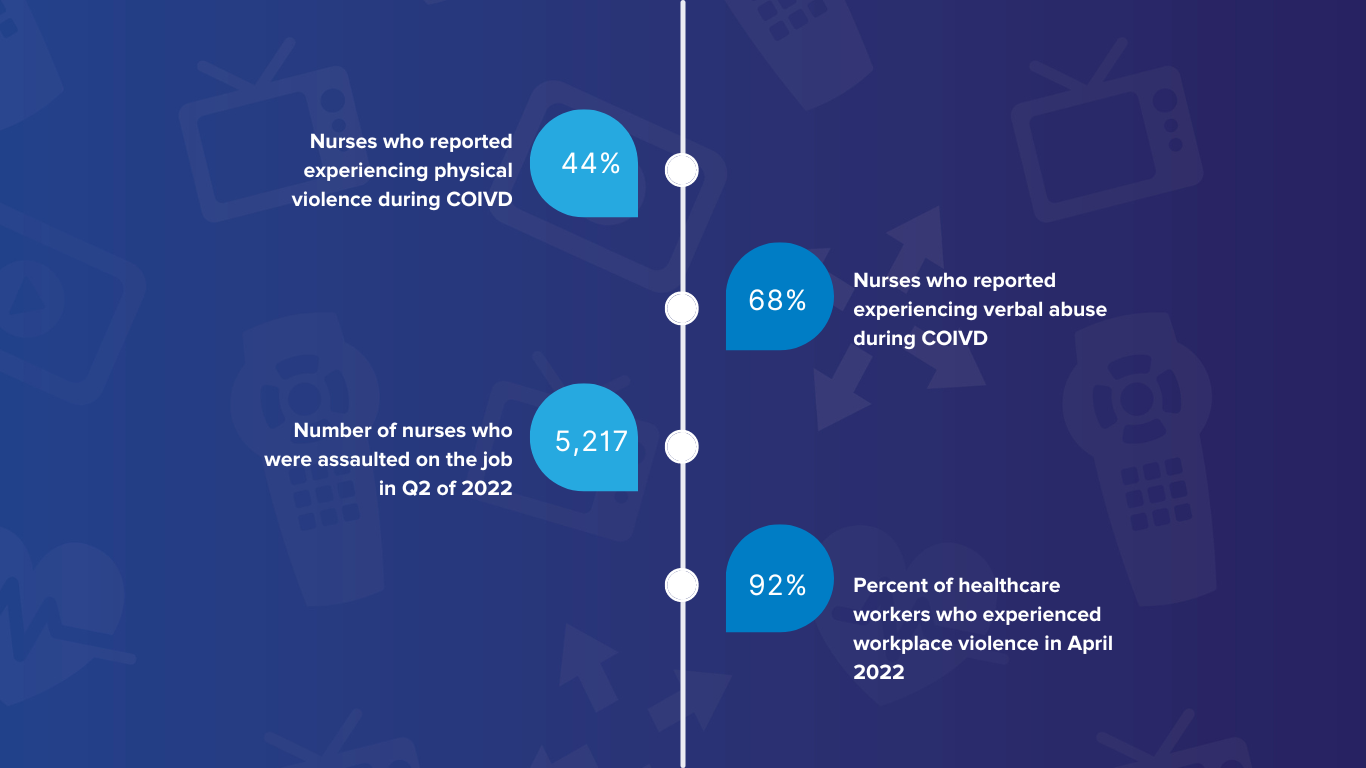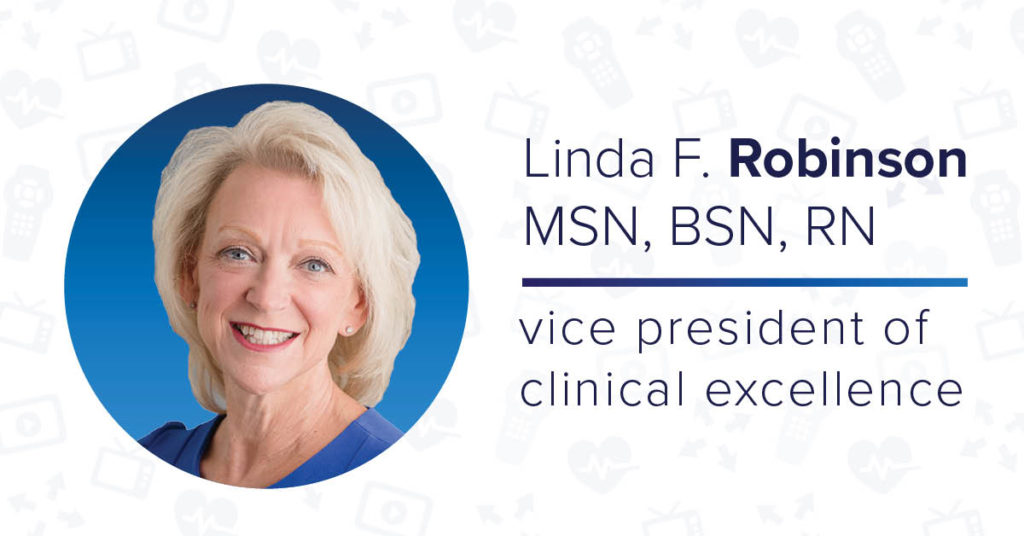
Hospital workplace violence has been a problem in the healthcare industry for decades, but the COVID-19 pandemic has exacerbated the situation. The VP of Clinical Excellence at MDM Healthcare, Linda Robinson, MSN, BSN, RN has been an advocate for the issue of hospital workplace violence throughout her career. She consulted with other state nursing organizations on healthcare workplace violence legislation. She co-authored a published national workplace violence research study for the National Emergency Nurses Association. Also, she has also been named an ANCC Magnet exemplar, which was obtained for workplace safety violence prevention work. These are just some of her many achievements as they relate to this topic. Robinson sat down with us for an interview to discuss the issue and suggest ways hospitals could combat the problem and move forward to a safer, healthier hospital environment. “I worked in the Emergency Department for many years, and I also worked in the ICU prior to that. Healthcare safety and security really became something that I was faced with early on. When I went to the emergency department, I was amazed at how violent it was, and so I have really dedicated a lot of my career to addressing the issue,” she said.

Incidents of workplace violence against healthcare workers had been on the rise before the pandemic. A report published by the U.S. The Bureau of Labor in 2018 stated that the issue was of growing concern in the industry and that healthcare workers were “ five times more likely to experience workplace violence than employees in all other industries.” This was the state of conditions leading up to the onset of the COVID-19 pandemic in March of 2020. Robinson explained that the stressful working conditions at hospitals were intensified by the pandemic, which ultimately resulted in more verbal, and even physical abuse of healthcare workers. “I noticed the problem when I started at the Emergency Department in 2003, but since COVID, it seems to have just really gotten much worse. A lot of that has been caused by fear of the disease, and stress from the quarantine measures,” Robinson said. Staggering statistics continue to be reported relating to this issue. A recent article published by healthcare research group Press Ganey, revealed more than two nursing personnel were assaulted every hour in the second quarter of 2022. That equates to roughly 57 assaults per day, 1,739 assaults per month, and 5,217 assaults per quarter.

Robinson noted that hospital violence comes in a variety of forms, all of which are dangerous. “Violence is not always physical. If you have apathy towards verbal abuse you create an environment that is conducive to the escalation of that verbal abuse to physical assault,” she said. Another aspect of the problem is the underreporting of incidents by healthcare workers. In many cases, nurses don't even report incidents of violence. According to the U.S. Department of Labor, workplace violence is a recognized hazard in the healthcare industry, and unfortunately, many more incidents probably go unreported. “Studies show us that 30% of nurses do not report incidents of workplace violence. Nurses believe it’s part of the job. In a lot of organizations reporting is voluntary, so there's a lack of reporting policy,” said Robinson.
Robinson stressed the need for hospital leadership to take action. “If you're in a leadership position where you can advocate for nursing and hospital safety, it is imperative that you do that,” she said. “If a nurse cannot give care or leaves nursing because of an injury or because they don't feel safe, then we're losing good nurses,” she continued.

Many advocates in the industry including Robinson point out that there are no federal laws protecting healthcare workers from this type of violence, and that part of solving the issue is a legislative response. A recent report published by the American Hospital Association (AHA) states, “Hospitals, health systems and their employees have expressed a strong interest in the enactment of a federal law that would protect health care workers from violence and intimidation, just as current federal law protects airline and airport workers. Congress should enact the Safety from Violence for Healthcare Employees (SAVE) Act, which provides protections similar to those that exist for flight crews, flight attendants and airport workers.” In addition to a legislative response, a Sentinel Event Alert, which was revised since the COVID pandemic, was published by the Joint Commission. It created standards for a framework to guide hospitals and critical access hospitals in dealing with violence.
Robinson drew on her expertise as a longtime advocate for the issue and explained that there are several things that hospitals can do to establish safer working environments. “Hospitals need to talk to their staff and give them a seat at the table so that they can be honest about what's happening. Safety is everyone's first priority, and there should be a zero-tolerance policy for violence,” she said. It's very important that we take it seriously and we intervene, and we offer services to staff who have gone through workplace violence incidents,” she continued. Robinson also suggested that hospitals focus on teaching staff how to identify and prevent dangerous conditions in the early stages before the violence escalates and injuries occur. She also suggested hospitals analyze the conditions that contributed to violent incidents after they occur, implement a behavioral emergency response team, educate workers on de-escalation techniques., and invest in security infrastructure.
The Role of Technology and How MDM Healthcare Can Help
Robinson suggested that the innovative use of technology could help improve conditions in the hospital environment, which would also help to reduce violent incidents. “I think that's where MDM comes in and I'll tell you that's one of the reasons I’m there. I'm passionate about patient and family-centered care, and patient experience, but again, I am a passionate advocate for nursing. It's so exciting to be working with technology that can really help give people a better quality of care,” she said.
Technology helps nurses work more efficiently, which is even more beneficial in light of the current nursing shortage. “Nurses can't be everything to everybody. They can't be in that room all the time, they have a number of patients to care for. When you think of patient engagement technology, it provides a lot of information in that room that really helps the patient not have to call out to their nurse constantly,” said Robinson.
Information sharing also keeps patients and families calm by providing them peace of mind. Vital health data can be shared in real-time using Journey PX’s digital whiteboard solution, My Day Today. “The digital whiteboard has a patient’s daily plan of care, everything that's going to happen, and many other important answers to patients' questions. On that digital whiteboard, but then also within that system, there is a whole lot of information about the hospital,” said Robinson. A variety of questions are answered by the patient engagement technology, the technology also allows patients to access services such as meals, housekeeping and entertainment. “It keeps tension down and fosters a more positive work environment, as patients don’t need to call their nurse for everything they need,” Robinson noted. This technology also helps calm the confusion and frustration that can sometimes be felt by a patient's family and care partners as it also keeps them informed.
The sharing of vital information is only one of many technology solutions used in Journey PX, which helps cultivate a more tranquil hospital environment. “Another thing I would mention are the distraction pieces that are available in Journey PX solution My Stay, This solution includes access to calming videos on demand to help patients relax, and a vast library of Hollywood and patient education videos to help keep patients entertained,” said Robinson. Journey PX also allows the hospital to send out vital safety messages to each patient when an emergency takes place, such as a hurricane, tornado, or other crisis. In addition, the technology provides a reminder for patients when visiting hours are coming to a close so they can obtain a visitor’s badge for essential family members if needed. Robinson knows that technology can make a difference in creating a safer environment at hospitals. “Those prompts can go out to every patient at the facility, really transforming the environment,” she said. Keeping patients connected with loved ones and care providers virtually is another technology solution that helps create a more pleasant hospital environment. The Journey PX Connect platform enables video calling for patients, care teams and families. This solution is another example of how technology can help in decreasing a patient's fear and frustrations while in the hospital. “The ability to do that innovatively with a patient engagement technology solution is pretty endless. At Journey PX we ask hospital organizations to provide us with their key quality and safety issues they want to address, and we brainstorm with them and design the solution to meet their needs and to meet their patients and their staff's needs,” Robinson stated.
The issue of hospital workplace violence is complex and combating the problem requires a variety of actions be taken, such as those outlined above. At MDM Healthcare, we are proud to know our technology solutions can help be a part of a comprehensive strategy to address the problem. For Robinson, her passion for this issue and years dedicated to it have been fueled by her love for her patients and fellow nurses. “I always tell nurses this: as far back as 1893, nurse and advocate Florence Nightingale, had the intent to allow nurses the autonomy of purpose to advocate for patients. However, she also said to advocate for the nursing profession, and that's something that frontline nurses, all nurses must do,” she said.
Listen to the full interview on the PX Space podcast available on Apple Podcasts, Spotify, and Amazon Music.


